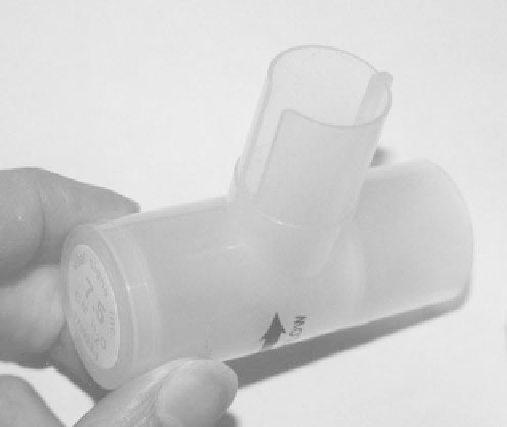Biomedical Engineering Reference
In-Depth Information
change in the absorbent, which acts as a visual indicator
of the absorbent's activity. The color of absorbent
changes from off-white to violet as its ability to absorb
carbon dioxide diminishes. Under certain, but rare,
conditions, the color change reverts to the original. A
more common problem is that users overlook, or forget
to notice, the color change. In addition, optical properties
of the housing can change, thus making the color change
difficult to see. Channeling occurs when respiratory gases
take the path of least resistance and channel through
a relatively narrow cross-section. This can result in
unwanted inspired carbon dioxide.
Heat and water are by-products of CO
2
absorption.
The heat generated is not excessive and is beneficial to
the patient because it helps to warm cool supply gases,
which could irritate the lung lining. Water produced is
also beneficial because supply gases are dry, and added
moisture reduces lung irritation. If water production is
neglected, it will build to the point where it could con-
tribute to problems in the breathing circuit. The most
frequently noted problems are sticking expiratory check
valves from surface tension between valve disc and
housing, and water accumulation in hoses and tubing to
the ventilator, affecting proper function by inhibiting
proper pressure sensing and gas flow.
Figure 4.4-4 Example of a PEEP valve.
collapse. During positive-pressure ventilation, the
ventilator maintains a slight PEEP (2-3 cm H
2
O) to
accomplish the same. Clinical indications (e.g., adult
respiratory distress syndrome [ARDS]), PEEP valves are
used to increase the resistance that a patient encounters
during exhalation, increasing the residual volume in their
lungs. Different models of PEEP valves can be perma-
nently installed either on the machine/absorber or tem-
porarily on the expiratory limb. For the latter, the design
is a variation of a check valve, making it dangerous if
installed backwards or in the inspiratory limb, as it would
result in little gas flow and inadequate oxygenation
(
Figure 4.4-4
).
Gas scavengers
When the machine is set for an FGF rate of anything
higher than the patient's uptake (normally 200-300 ml of
oxygen per minute for most adults), any excess must be
removed to avoid a build-up of volume as discussed above.
Although PEEP is used for certain clinical indications, its
uncontrolled application is disastrous for the patient. The
scavenging system plays a vital role in conjunction with
the breathing circuit to prevent this from happening.
During automated ventilation, the bellows pop-off valve
opens at the end of tidal expiration to divert excess
volume to the scavenging system. During manual venti-
lation, the user must open and close (as necessary) an
adjustable pressure-limiting (APL) valve to set the upper
limit for breathing-circuit pressures. If the APL valve is
open, or any pressure occurs in excess of its setting, gas
flows to the scavenger. The physical construction of
scavengers used on the machines varies and can require
user interaction. The various designs offer their own risks
and benefits; some put greater demands on the hospital
infrastructure (vacuum pumps), while others require the
user to make adjustments according to FGF rate.
Humidification
As discussed previously, supply gases are dry and can ir-
ritate the lung's lining, particularly with susceptible
patients who are on the machine for extended periods.
Although the use of active humidifiers has declined over
the years, they may still be used for certain patients. Two
techniques are used to maintain moisture in the gas that
the patient breathes: the heated active humidifier and
the heat moisture exchanger (HME).
Active heated units are generally more effective in
adding both humidity and heat to the breathing circuit.
The operator must connect the unit to an electrical
power source, must monitor its temperature, and must
clean and fill them. Many units incorporate check valves
to prevent inadvertent delivery of fluid to the patient if
they are installed incorrectly. Backward installation can
result in significant flow restriction and inadequate oxy-
genation. These units are installed in the inspiratory limb
and have a predetermined ''in'' and ''out.''
PEEP valves
During spontaneous ventilation, the body maintains a
residual volume in its lungs to prevent them from









